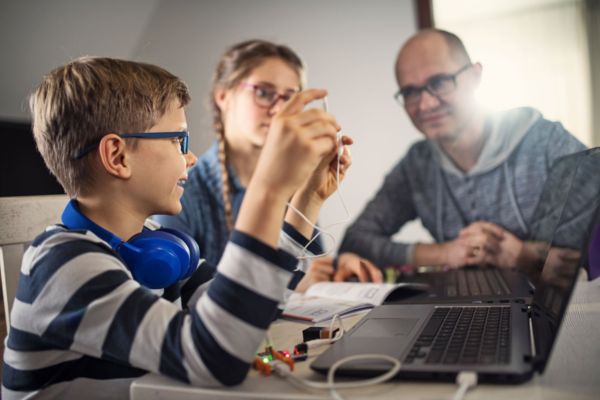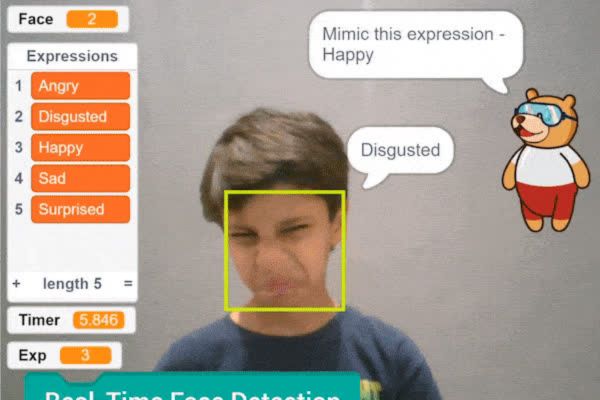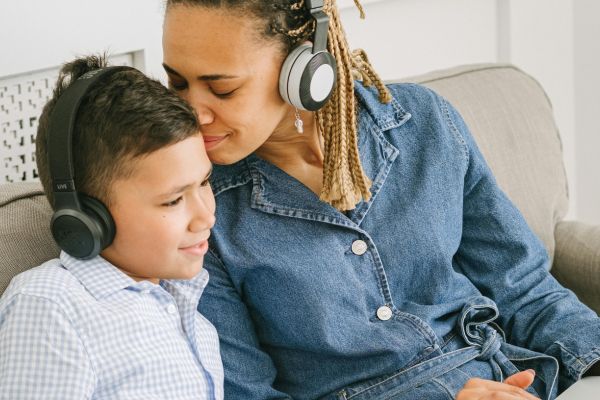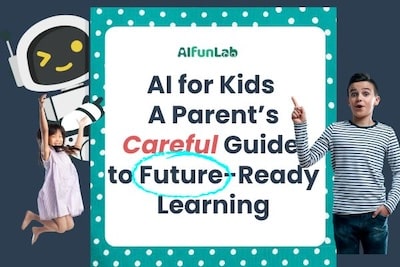Hi there, fellow parents! 👋Like you, we’re raising kids in a world where adaptability, self-learning, and creativity matter more than ever. The future is exciting, but it's also rapidly changing. Here’s why we built AIFunLab.io—and why we’re picky about the AI tools we recommend.
Why We Believe in AI (But Only the Right Kind)Before kids, my work in finance and startups across Asia showed me something profound: truly successful young people weren't always the ones with fancy degrees. They were the adaptable, self-driven, and creative thinkers.
Now, as parents, we see it firsthand:
- Schools can’t teach everything.
- The skills needed for tomorrow's jobs—like problem-solving and creative thinking, often fostered through engaging problem solving activities for kids—go beyond memorization.
- AI tools, when chosen wisely, can help kids build these crucial skills by doing, exploring, and creating (think coding games or animating stories) instead of just passively consuming. This includes finding the best AI homework helper that guides understanding, and even discovering AI homework helper free options that empower learning without roadblocks.
But let’s be real: We’re not handing over the iPad and hoping for the best.

The Problems We Actively AvoidWe’ve personally tested hundreds of AI apps and tools. Here’s what we actively filter out, ensuring every recommendation meets our family’s high standards:
- 🚫 Addictive Screen Time: We prioritize engagement that fosters healthy habits, not mindless scrolling.
- 🚫 Inappropriate or Violent Themes: No "shoot-em-up" games or content that promotes aggression.
- 🚫 Spiritual/Mystical Content: We personally avoid anything with occult, karma, or witchy themes.
- 🚫 Low-Quality Apps: We skip tools that are just flashy gimmicks, don't last, or offer little genuine learning value.
- 🚫 Unpredictable AI Conversations: We ensure interactions are safe and don't veer into weird or unsafe territory.
Ready to dive deeper? Why not jumpstart their journey with our hands-on3-day AI Adventure? For a balanced perspective, explore the pros and cons of AI in education, and see the impact these tools are making by reviewing the list of awards our recommended platforms have earned.Our Solution: A Curated Guide for ParentsThis isn’t another generic “top 10 apps” list. AIFunLab.io is a carefully curated, parent-tested guide to AI tools and projects that pass our rigorous standards for:
- ✅ Real Educational Value: Tools that genuinely support learning, critical thinking, and development.
- ✅ Safety First: Age-appropriate content with robust privacy protections.
- ✅ Engaging & Adaptable: Tools that keep kids motivated and adjust to their individual pace.
- ✅ Sparking Creativity: Projects that encourage kids to build, create, and express themselves.
What You’ll Find Here
- Vetted AI apps for math, coding, writing, logic, and creativity.
- Hands-on AI projects your kids can actually do (like animating toys or building simple games).
- Free resources and kits to help you navigate tech with confidence.
- Honest recommendations from parents who get it—not sponsored fluff.
- We’re constantly updating this guide—and just because a tool isn't listed yet doesn't mean it's bad. We're being thoughtful with every recommendation.
👉 Explore Our AI App Directory
👉 Try Our 3-Day AI Challenge for Kids

AI for Math: Problem-Solving and Learning That Sticks
AI-powered math tools are changing the game. They don’t just drill equations—they adapt to your child's pace, explain concepts visually, and even make math feel fun. Here are our top picks for different types of learners, plus what to skip.
Honorable Mentions (Covered in Our Math Directory)
Some apps are decent but didn’t make our top list:
- CK-12 (Flexi): Strong for independent learners, but less engaging for younger kids.
- Buzzmath: Great logic activities but lacks fun.
- Brilliant: Better for older learners or teens.
- Synthesis: Excellent logic training, covered under both math and STEM.
Build Fluency Fast
Komodo Math
✅ Best for: Ages 5–11; great for reward-motivated learners
🧠 Why it stands out: Quick games teach times tables without fantasy distractions. Parents love the progress dashboard.
💡 Pro tip: Use in short 10-min bursts; mix with offline puzzles.
DoodleMath
✅ Best for: Ages 5–11; perfect for kids who thrive on daily practice
🧠 Why it stands out: Adaptive learning with printable worksheets. Feels like a tutor.
💡 Pro tip: Daily rewards keep kids coming back—just balance with other activities.
Ready to dive deeper? Why not jumpstart their journey with our hands-on 3-day AI Adventure? For a balanced perspective, explore the pros and cons of AI in education, and see the impact these tools are making by reviewing the list of awards our recommended platforms have earned.

Crush Homework (Responsibly)
UpStudy
✅ Best for: Ages 7–11; kids needing help solving word problems
🧠 Why it stands out: Snap a photo and get kid-friendly explanations. Better than Photomath.
💡 Pro tip: Guide kids to understand, not just copy answers.
Sizzle AI
✅ Best for: Ages 8–11; ideal for curious learners
🧠 Why it stands out: Walks kids through problem-solving steps. Encourages understanding.
💡 Pro tip: Set time limits to avoid screen fatigue.
Studyable
✅ Best for: Ages 9–11; kids who study independently
🧠 Why it stands out: Turns notes into quizzes, flashcards, and study help.
💡 Pro tip: Occasionally check AI-generated content for accuracy.
Build Strong Foundations
Elephant Learning
✅ Best for: Ages 5–11; kids needing confidence in math
🧠 Why it stands out: Promises a 1.5-year math boost in just 10 weeks. Highly structured.
💡 Pro tip: Budget for the $35/mo cost and use 2–3x per week.
Khan Academy Kids
✅ Best for: Ages 4–8; younger learners who enjoy characters
🧠 Why it stands out: Ad-free, free forever, with playful visuals.
💡 Pro tip: May be too easy for kids 9+, so plan a transition.
Flexi (CK-12)
✅ Best for: Ages 6–11; curious learners who like to explore
🧠 Why it stands out: Adaptive and in-depth lessons, great for self-paced kids.
💡 Pro tip: Pair with hands-on math activities to balance screen time.
Quick Guide: Best Math Apps by Age
- Ages 4–6: Khan Academy Kids, Komodo, DragonBox
- Ages 6–8: Komodo, Brighterly, Synthesis
- Ages 8–10: Elephant Learning, Khanmigo, Beast Academy
- Ages 10–11: Photomath, Brilliant (with guidance), Beast Academy

AI for Coding, STEM & Robotics: Building Tomorrow's Innovators
Some kids light up when they can tell a story. Others? They'd rather build a robot, write a game, or figure out how something works. For these logical, hands-on learners, AI and coding tools offer a window into the future—and a fun one at that.
These picks go beyond typical STEM apps. We focused on tools that:
- Encourage systems thinking and problem-solving
- Let kids build or design their own projects
- Include AI-specific elements (like training a chatbot or recognizing patterns)
Top Picks
ScratchJr
✅ Best for: Ages 5–7; young kids just getting started with code
🧠 Why it stands out: Introduces logic, sequencing, and design through drag-and-drop play. Great for storytelling and creative games.
💡 Pro tip: Kids may outgrow it fast—transition to full Scratch when ready.
Pictoblox
✅ Best for: Ages 6–11; kids interested in robotics, coding, and AI tools
🧠 Why it stands out: Lets kids code with blocks, then connect to real hardware (like Arduino or robots). Includes AI features like face recognition.
💡 Watch out for: Voice and hardware features can be buggy; needs some patience.
Machine Learning for Kids
✅ Best for: Ages 9–12; curious kids ready for deeper AI exploration
🧠 Why it stands out: Kids train actual machine learning models and use them in Scratch or Python. Turns abstract AI into something hands-on.
💡 Pro tip: Needs a computer, not a tablet. Younger kids will need setup help.
Flexi (CK-12)
✅ Best for: Ages 7–11; imaginative kids who want to build something useful
🧠 Why it stands out: Unlike most apps, Flexi lets kids create quiz bots or simple tools—no coding needed. Logic-first approach.
💡 Pro tip: Better in short creative sessions than as a full curriculum.
Honorable Mentions (Covered in Math)
These tools build STEM skills but were featured earlier:
- Synthesis – Develops logic and systems thinking. [See Math section]
- Brilliant – For logic puzzles and beginner programming. [See Math section]
- Buzzmath – Reinforces reasoning through math. [See Math section]
- Khan Academy – Includes CS courses, but we covered it earlier. [See Math section]
- Khanmigo – Some coding Q&A, but lacks project flow. [See Math section]
Quick Guide: Best STEM & Coding Apps by Age
- Ages 5–7: ScratchJr, Pictoblox (basic use)
- Ages 7–9: Pictoblox, Flexi AI
- Ages 9–11: Machine Learning for Kids, Pictoblox (advanced), Flexi AI

AI Homework Helpers: Smart Study Support (Without Doing All the Work)
AI homework tools can be helpful allies—as long as they're used the right way. These tools explain, quiz, and encourage thinking. Yes, they are used for shortcuts. And that’s why we need to get involved so we can help kids use AI to building confidence and independence.
Top AI Homework Tools for Kids
Studyable
✅ Best for: Ages 9–11; independent learners or test prep
🧠 Why it stands out: Converts notes into flashcards and quizzes. Clear, focused explanations.
💡 Pro tip: Use to prep for quizzes or reinforce tricky topics.
EduBrain
✅ Best for: Ages 8–11; kids who need step-by-step support
🧠 Why it stands out: Friendly interface with voice/text help, adjusts to learning style.
💡 Pro tip: Great for kids who feel overwhelmed or avoid starting homework.
Sizzle AI
✅ Best for: Ages 8–11; questioners who love breaking things down
🧠 Why it stands out: Encourages understanding over copying. Explains process clearly.
💡 Pro tip: Use in 20-minute sessions with review afterward for best results.
Beyond this guide, discover more focused support: find in-depth strategies on our AI Homework Helpers post, explore exciting STEM competitions, and for a complete overview of all vetted recommendations, visit our comprehensive AI App Directory.
UpStudy (previously in Math)
✅ Best for: Ages 7–11; helpful for math word problems
🧠 Why it stands out: Instant photo-to-explanation, tailored for kids.
💡 Pro tip: Better used with guidance than solo.
Flexi AI, ChatGPT, Gemini (Covered in other sections)
- Flexi: Great for quiz-building and structured responses
- ChatGPT: Works well with supervision for rewriting, planning, or brainstorming
- Gemini: Strong for summarizing, especially with web sources
Quick Guide: Best AI Homework Tools by Age
- Ages 7–8: UpStudy (with help), EduBrain (guided), Flexi
- Ages 8–9: EduBrain, Sizzle AI
- Ages 9–11: Studyable, Sizzle AI, ChatGPT (with limits)
Beyond this guide, discover more focused support: find in-depth strategies on our AI Homework Helpers post, explore exciting STEM competitions, and for a complete overview of all vetted recommendations, visit our comprehensive AI App Directory.

AI for Language Learning: Speak, Play, and Learn Naturally
Speaking more than one language is a superpower—and AI can help your child unlock it. Bilingual kids often show better focus, creativity, and memory. In countries like Switzerland, Singapore, and the Netherlands, growing up bilingual or trilingual is the norm.
But for English-speaking households, especially where parents don’t speak a second language, it can be hard to reinforce learning. That’s where AI-powered language tools shine. These apps make speaking, reading, and understanding new languages feel fun, not like homework.
We picked tools based on age, interactivity, and how well they support real conversational learning. Here are the standouts:
Top AI Language Learning Tools for Kids
Lexi AI
✅ Best for: Ages 6–11; kids learning English (ESL) or Spanish through conversation
🌐 Languages: English (ESL), Spanish, French (beta)
🧠 Why it stands out: Built for kids, it adapts in real time with playful, personalized conversations.
💡 Pro tip: Works well for kids who prefer talking to tapping. Use in quiet spaces for best voice results.
LingoLooper
✅ Best for: Ages 5–10; playful language practice with characters
🌐 Languages: Mandarin, Spanish, French
🧠 Why it stands out: Immerses kids in role-play dialogue with instant pronunciation feedback.
💡 Pro tip: Use headphones to help kids engage fully.
FabuLingua
✅ Best for: Ages 4–8; young kids learning Spanish through stories
🌐 Languages: Spanish (from English)
🧠 Why it stands out: Charming stories blend English and Spanish for natural absorption.
💡 Pro tip: Great for bedtime stories or read-alongs with a parent.
HelloChinese
✅ Best for: Ages 8–11; structured Mandarin learners
🌐 Languages: Mandarin (from English)
🧠 Why it stands out: Covers tones, grammar, culture, and pronunciation using AI voice correction.
💡 Pro tip: Focus on speaking/listening modules first; writing can come later.
Ready to dive deeper? Why not jumpstart their journey with our hands-on3-day AI Adventure? For a balanced perspective, explore the pros and cons of AI in education, and see the impact these tools are making by reviewing the list of awards our recommended platforms have earned.

Promova
✅ Best for: Ages 9–11 (with guidance); great for ESL learners or those with reading challenges
🌐 Languages: English (ESL), Spanish, French, German, Italian
🧠 Why it stands out: Bite-sized pronunciation and phonics support, especially good for dyslexia or neurodiverse learners.
💡 Pro tip: Interface is more adult-focused; younger kids may need help navigating.
Honorable Mentions (Use with Supervision)
Duolingo
- Fun for older kids but heavy on streaks and repetition. Can feel gamified more than educational.
- Watch for ads and distractions unless on paid plan.
Lingokids
- Was strong for young ESL learners, but recent changes made it more commercial and less rich in content.
Readability Tutor
- Helpful for English fluency and reading support, but not ideal for full language acquisition.
Beyond this guide, discover more focused support: find in-depth strategies on our AI Homework Helpers post, explore exciting STEM competitions, and for a complete overview of all vetted recommendations, visit our comprehensive AI App Directory.
Quick Guide: Best Language Tools by Age & Language
- Ages 4–6: FabuLingua (Spanish), Lingokids (English)
- Ages 6–8: Lexi (English/Spanish), LingoLooper (Mandarin/Spanish/French)
- Ages 8–11: HelloChinese (Mandarin), Promova (ESL or dyslexia), Lexi (advanced)
Let me know when you're ready to move to the next section: AI for Special Needs.
Quick Guide: Best Language Apps by Language
- Spanish: Lexi, FabuLingua, LingoLooper
- Mandarin: HelloChinese, LingoLooper
- English (ESL): Lexi, Promova, Readability Tutor
- French: Lexi (beta), LingoLooper, Promova
- Other (German, Italian): Promova only (best for older learners)

AI Tools for Special Needs: Flexible Support for Unique Learners
Every child deserves tools that meet them where they are. For families raising neurodivergent children—whether navigating ADHD, autism, dyslexia, or emotional regulation challenges—traditional apps often fall short. That’s where AI can be surprisingly helpful.
These tools don’t promise miracles, but they do offer:
- Adaptability — learning at your child’s pace
- Consistency — without frustration or judgment
- Structure or freedom, depending on what your child needs most
Here are the most talked-about AI tools parents are using to support learning, routines, and emotional wellbeing at home.
Emotional & Communication Support
Teddy AI
✅ Best for: Ages 7+; kids who need a non-judgmental companion to talk through feelings, worries, or just their day
🧠 Why it stands out: Teddy offers consistent, personalized conversations. Parents say it creates a safe space for self-expression—especially for kids who aren’t ready to talk to adults.
💡 Watch out for: It’s still an AI chatbot. Parental oversight is key to help kids understand boundaries and keep expectations healthy.
Autism & Early Learning Delays
Otsimo
✅ Best for: Ages 1+; especially helpful for children with autism, speech delays, or early developmental challenges
🧠 Why it stands out: Created with special ed experts, Otsimo offers adaptive learning games that support cognitive, motor, and communication development through structured, screen-guided play.
💡 Pro tip: The free version is limited—most parents recommend the paid tier for access to fully personalized activities.
Parent Guidance & Developmental Insight
Hazel
✅ Best for: Parents and caregivers looking to better understand their child’s needs
🧠 Why it stands out: Hazel uses quick screeners and feedback tools to help parents identify patterns, strengths, and possible areas for support. It’s like having a parenting coach in your pocket.
💡 Watch out for: It’s not a diagnostic tool—think of it as a conversation starter, not a replacement for clinical evaluation.
Routine & Structure Support (for ADHD & Autism)
Tiimo
✅ Best for: All ages; especially helpful for kids who thrive with visual cues and consistent transitions
🧠 Why it stands out: Tiimo makes daily life easier to manage with visual timers, task lists, and routine prompts. It’s used by many autistic and ADHD families to reduce anxiety and increase independence.
💡 Pro tip: The basic version works well, but advanced features (like schedule syncing and themes) require a paid plan.
Ready to dive deeper? Why not jumpstart their journey with our hands-on3-day AI Adventure? For a balanced perspective, explore the pros and cons of AI in education, and see the impact these tools are making by reviewing the list of awards our recommended platforms have earned.
Clinical & Diagnostic Tools
EndeavorRx
✅ Best for: Ages 8–17; kids diagnosed with ADHD (primarily inattentive or combined type)
🧠 Why it stands out: This is the first FDA-authorized digital treatment for ADHD—clinically proven to improve attention through targeted video game play.
💡 Watch out for: It’s prescription-only. Designed to support, not replace, other therapies.
Gamified Behavior & Motivation Apps
Joon
✅ Best for: Ages 6–12; kids who resist routines, chores, or personal habits
🧠 Why it stands out: Joon gamifies daily tasks. Kids complete real-world goals to care for a digital pet, turning everyday challenges into achievable adventures. Parents say it improves cooperation and follow-through.
💡 Watch out for: Works best when both child and parent use the app. Paid plans unlock the full experience.
Focus & Productivity Tools (for Teens)
Focus To-Do
✅ Best for: Teens & older students with ADHD or executive functioning challenges
🧠 Why it stands out: Combines the Pomodoro timer method with to-do lists. Helps older kids break big tasks into chunks, track progress, and stay focused.
💡 Pro tip: Not designed for kids—but tech-savvy tweens and teens can benefit with some parental setup.
Reading Fluency & Dyslexia Tools
Promova
✅ Best for: Ages 9–11 (with support); especially for kids struggling with phonics or reading pace
🧠 Why it stands out: Though not built for kids, Promova’s bite-size, AI-guided pronunciation lessons help reinforce phonics and boost fluency. Parents say it’s like having a calm, repeatable tutor.
💡 Watch out for: The interface isn’t designed for kids—but the structured repetition makes it useful for older children with dyslexia or processing delays.
✨ Also featured in our Language Learning section for its adaptive ESL support.

AI Creativity & Art Tools – Let Kids Be the Makers
There’s something magical about the moment a child sees their ideas come to life — a song they helped write, a poster they designed, a silly doodle turned into real art. These moments don’t just boost confidence — they spark identity. Suddenly, they’re not just watching or clicking — they’re a DJ, a designer, an animator, a storyteller.
In a world where most digital experiences are built for passive consumption, these AI tools flip the script. They give kids the power to create, design, and build — with just their imagination and a little guidance. Whether your child loves drawing, music, storytelling, or video, there’s a tool here that can take their creativity to the next level — and help them step confidently into the role of maker.
Drawing & Visual Imagination
AutoDraw
✅ Best for: Ages 5+; great for kids who love drawing but struggle with precision
🧠 Why it stands out: Uses AI to guess what your child is trying to draw, then offers “clean” versions. Feels empowering — not correcting.
💡 Pro tip: A great low-pressure art tool to support motor skills or storytelling projects.
Dalle Mini (Craiyon)
✅ Best for: Ages 7+; kids who like surreal, imaginative visuals
🧠 Why it stands out: It turns typed phrases into unique images — great for creative prompts, story starters, or just laughing at weird AI mashups.
💡 Watch out for: Results can be hit-or-miss. Not polished, but fun in its randomness.
Delightex
✅ Best for: Ages 8–11; curious kids who want to design immersive worlds
🧠 Why it stands out: It’s like building your own educational video game. Great for visual learners who like to “see how things work.”
💡 Pro tip: Best used on tablet or desktop with some adult guidance.
PicsArt for Kids (Android only)
✅ Best for: Ages 3–6; early learners or preschoolers who love art time
🧠 Why it stands out: Combines drawing and early literacy with spoken prompts. Good starter app for tech + creativity.
💡 Watch out for: Only available on Android devices (not iOS).
Canva
✅ Best for: Ages 8+; especially kids who want to create real-looking projects
🧠 Why it stands out: The drag-and-drop interface is intuitive, and Canva’s free version includes templates for stories, flyers, and more.
💡 Pro tip: Pair with a school project or creative writing prompt — kids love seeing their work look “professional.”
AI Animation & Video Creation
Hailuo AI
✅ Best for: Ages 9–11; kids who want to bring their drawings or characters to life
🧠 Why it stands out: It animates static images using AI motion — very fun for storytelling or presentations.
💡 Pro tip: Try using with drawings made in Canva or AutoDraw!
Kling AI
✅ Best for: Ages 10+; older kids who want to experiment with video + imagination
🧠 Why it stands out: Powerful tool that creates fluid video from just a phrase. Feels like a filmmaking magic wand — though it's still in beta.
💡 Watch out for: Younger kids might need help navigating the UI. Best as a co-play tool.
Music & Sound Creation
Suno AI
✅ Best for: Ages 8–11; music lovers and storytellers
🧠 Why it stands out: Just type "a song about my cat in space," and Suno makes a track with lyrics. Great for creative writing tie-ins.
💡 Pro tip: Works well in small group projects or sibling duos. Keep headphones handy!
Also Consider (with Supervision)
Midjourney
🧠 Best for: Adults or older teens with supervision. You’ll need Discord access and the results can sometimes include mature or confusing visuals.
❗ Not recommended for unsupervised child use.

Here's a revised conclusion for your flagship blog post, designed to be engaging, conversational, and strategically place your calls to action, avoiding a dense list while still providing clear next steps.
The Future of Learning, Empowered by AI (and You!)
We've explored how AI is truly reshaping learning, offering incredible personalized support for everything from mastering math concepts to embracing neurodiversity, and even unlocking new languages. It's clear that when chosen thoughtfully, these tools aren't just about screen time; they're about building future-ready skills, sparking curiosity, and empowering our children to navigate a complex world with confidence.
Ready to dive deeper and discover the perfect AI tools for your child? Our comprehensive AI App Directory is your go-to resource, featuring all the vetted apps we've discussed and many more, each with detailed insights and parent reviews.
And for a truly hands-on experience, why not kickstart their journey with our 3-day AI Adventure? It's a fantastic way to see AI in action and spark their imagination. If math is where you'd like to begin, you can also explore our dedicated AI Math Tools collection for even more focused recommendations.
Let's embrace this exciting future of learning, together.
After grad school at the London School of Economics, I worked in finance in Hong Kong, where I saw how school, access, and networks open doors into industries like private equity. Startups later took me to China and the Bay Area — where access still matters, but the timing coincided with a bigger shift. Crypto, social media, and AI began rewriting the rules. Dropouts now outpace Ivy grads, and kids build leverage before résumés. At AI Fun Lab, we help parents and educators make sense of this shift — and raise kids who can think fast and adapt.



.svg)




















